Oxford University Press's Blog, page 733
November 25, 2014
Band Aid (an infographic)
On this day in 1984, musical aficionados from the worlds of pop and rock came together to record the iconic ‘Do They Know It’s Christmas?’ single for Band Aid. The single has gone down in history as an example of the power of music to help right the wrongs in the world. The song leapt to the number one spot over the Christmas of 1984, selling over a million copies in under a week and totalling sales of three million by the end of that year. The Band Aid super-group featured the cream of eighties pop, including David Bowie, Phil Collins, George Michael, Sting, Cliff Richard and Paul McCartney.
The sales target for the single was £70,000, all of which was to be donated to the African famine relief fund. With support from Radio 1 DJs and a Top of the Pops Christmas Special, sales sky-rocketed and Geldof, feeling the strength of public opinion behind him, went toe-to-toe with the conservative government in an attempt to have tax on the single waived. Margaret Thatcher initially refused the plea, but as public outcry grew, Thatcher caved-in to public demands and the tax on sales worth nearly £9 million was donated back to charity.
Bob Geldof and a host of artists old and new have re-recorded the single to help raise funds to stem the Ebola crisis. Our infographic marks the 30th anniversary of the original recording and illustrates the movers and shakers that made this monumental milestone in pop history possible.

To view free articles examining the cause, the people, and the music, you can open the graphic as a PDF.
Headline image credit: Live Aid at JFK Stadium, Philadelphia, 1985. CC BY-SA 3.0 via Wikimedia Commons.
The post Band Aid (an infographic) appeared first on OUPblog.









 Related StoriesA guide to European cartelsPeanut butter: the vegetarian conspiracyKeytar Appreciation 101
Related StoriesA guide to European cartelsPeanut butter: the vegetarian conspiracyKeytar Appreciation 101
The not so thin blue line: policing economic crime
Fraud is one of the most costly crimes to society, with the last estimate produced by the now disbanded National Fraud Authority suggesting that in 2012 this figure was £52 billion. Yet the response from the Government, from the criminal justice system, and – most importantly – law enforcement, does not match the magnitude of the problem.
These are difficult times for the police. The most recent statistics on police numbers suggesting that officer levels have returned to where they were in 2002 as a consequence of deep funding cuts imposed by the coalition government. Nevertheless, in view of the cost of fraud – which is certainly a significant under-estimation due to the fact that not all frauds are reported and no law enforcement agency has a 100% detection rate – the public has a right to expect that the policing response to fraud is proportionate to these losses, and on a par with resources dedicated to investigating other acquisitive crimes such as burglary and robbery.
We are told that crime rates are falling, so why would this be an issue? Well, closer inspection of the Crime Survey for England and Wales reveals that the estimate of crime does not include any data for credit or debit card fraud, yet the last estimate by the National Fraud Authority was that in 2012 fraud was estimated to have cost the financial services sector over £5 billion. Fraud itself is on the increase; data evidence shows that reported fraud by individuals has risen by 17% in the 12 months to the end of March 2014. Yet again, it is only right for the public to expect that there are adequate police resources to tackle this rising crime problem.
So let us explore what the policing response to fraud actually amounts to in terms of officers dedicated to investigating this type of crime. Over the last 20 years there have been several studies that have illustrated a decline in specialist police resources dedicated to investigating fraud. During the mid-1980s, research by Michael Levi suggested there were 588 fraud squad officers. The Fraud Review published in 2006 identified that this figure had reduced to 416, which included 126 in London, and that this resource was actually under threat. Further research conducted by Robert Gannon and Alan Doig in 2008 suggested that in the last decade there had been a slight reduction in the number of police officers dedicated to the investigation of fraud, to around 400 officers. This in itself evidences the low priority that fraud is given by law enforcement, when considering that numbers of police officers rose year on year from 2000 to 2010.
 Balancing The Account. Photo by Ken Teegardin. CC BY-SA 2.0 via Flickr
Balancing The Account. Photo by Ken Teegardin. CC BY-SA 2.0 via Flickr To obtain a more up-to-date picture of policing resources dedicated to fraud, during the Summer/Autumn of 2013 a research team from the University of Portsmouth’s Centre for Counter Fraud Studies used the Freedom of Information Act to obtain data from Police Constabularies on the resources dedicated to fraud and economic crime. The term ‘economic crime’ was used because some forces have an economic crime unit. However, these units focus not only on the investigation of fraud, but a range of other financially related offences such as money laundering, counterfeit currency, and criminal involvement in a financial enterprise to name but a few. The expectation was that, in line with the overall reduction in police numbers, this figure would show a further decline in resources dedicated to fraud.
This was not to be the case. The numbers show that the resources allocated to tackling economic crime – excluding ‘financial investigators’ – within police forces in England and Wales currently stands at 624.3 (full time equivalent), higher than in 2006. This figure represents a mix of specialist police and civilian investigators, reflecting current trends in the increased civilianisation of some policing activities.
However, do not get too euphoric: this figure actually represents only 0.27% of all police personnel, further illustrating that the trait of giving fraud the status of a “Cinderella crime” continues. Even more worrying is that of the 48 police constabularies in the UK, seven police forces claimed they did not have an economic crime unit. So, don’t become a victim of fraud in Cumbria, North Wales, Bedfordshire, or Gloucestershire to name a few, as there won’t be anybody available to investigate your case! This may also explain why many frauds reported to the national fraud reporting centre Action Fraud never get investigated. Similarly, how many civilian fraud investigators referring an internal fraud case to the police will be familiar with the response “the offender has been sacked, what more do you want?”
Although the ‘thin blue line’ turned out to be not so thin after all, when considering that the number of recorded fraud cases has risen by two fifths over the last three years, and that there are four times as many officers dedicated to investigating benefit fraud (which only accounts for £1.9 billion of a £52 billion fraud problem), the fact that the police are only able to offer 0.27% of the total resource to fraud and economic crime does seem rather thin. Whilst the announcement that the Metropolitan Police Operation Falcon will create the largest cyber-crime and fraud team in Europe, the present policing figures really do suggest that it’s ‘open season’ for fraudsters.
The post The not so thin blue line: policing economic crime appeared first on OUPblog.









 Related StoriesBack to the future with the ASC’s new Division of PolicingThe past, present, and future of overlapping intellectual property rightsThe importance of mentoring
Related StoriesBack to the future with the ASC’s new Division of PolicingThe past, present, and future of overlapping intellectual property rightsThe importance of mentoring
Peanut butter: the vegetarian conspiracy
There is something quintessentially American about peanut butter. While people in other parts of the world eat it, nowhere is it devoured with the same gusto as in the United States, where peanut butter is ensconced in an estimated 85% of home kitchens. Who exactly invented peanut butter is unknown; the only person to make that claim was Dr. John Harvey Kellogg, the chief medical officer at the Sanatarium, the fashionable health retreat in Battle Creek, Michigan. Kellogg, a vegetarian who invented Corn Flakes, was seeking an alternative for “cows’ butter.” He thought puréed nutmeats might work, and in the early 1890s Kellogg experimented with processing nuts through steel rollers. He served the nut butters to his patients at the Sanatarium, who loved them. Remarkably, in less than a decade peanut butter would emerge from the province of extremist “health nuts” to become a mainstream American fad food.
America’s elite visited the Battle Creek Sanatarium to recover their health, and many fell in love with the foods served there—particularly peanut butter. It soon became a passion with health-food advocates nationwide, and newspapers and magazines quoted vegetarians extolling its virtues. A vegetarianism advocate, Ellen Goodell Smith, published the first recipe for a peanut butter sandwich in her Practical Cook and Text Book for General Use (1896).
Homemade peanut butter was initially ground in a mortar and pestle, but this required considerable effort. It was also made with a hand-cranked meat- or coffee-grinder, but these did not produce a smooth butter. Joseph Lambert, an employee at the Sanatarium, adapted a meat-grinder to make it more suitable for producing nut butters at home. He also invented or acquired the rights to other small appliances, all intended to simplify the making of nut butters. These included a stovetop nut roaster, a small blancher (to remove the skins from the nuts), and a hand grinder that cranked out a smooth, creamy product. In 1896, Lambert left the Sanatarium and set up his own company to manufacture and sell the equipment.
Lambert mailed advertising flyers to households throughout the United States, and some recipients who bought the equipment started their own small businesses selling nut products. As nut butters became more popular, these machines proved inadequate to keep up with demand, so Lambert ramped up production of larger ones. He also published leaflets and booklets extolling the high food value of nuts and their butters. His wife, Almeda Lambert, published A Guide for Nut Cookery (1899), America’s first book devoted solely to cooking with nuts.
Vegetarians — who at the time practiced what we may now consider veganism — enjoyed all sorts of nut butters, which weren’t simply novel spreads for sandwiches but also sustaining, high-protein meat substitutes. But peanuts were the cheapest nuts, and it was peanut butter that dominated the field. It was first manufactured in small quantities by individuals and sold locally from door to door, but before long, small factories sprang up and peanut butter became a familiar article on grocers’ shelves. The American Vegetarian Society (AVS) sold peanut butter and actively promoted its sale through advertisements in magazines. In 1897 the AVS also began promoting the sale of the “Vegetarian Society Mill,” with an accompanying eight-page pamphlet encouraging vegetarians to create home-based peanut butter businesses. Vegetarians all over the country began to manufacture commercial peanut butter. The Vegetarian Food & Nut Company, in Washington, D.C., sold a product called “Dr. Shindler’s Peanut Butter” throughout the United States for decades. The company also produced private-label peanut butter for grocery store chains, and non-vegetarians quickly adopted the tasty new product.
The Atlantic Peanut Refinery in Philadelphia, launched in December 1898, may have been the first company to use the words “peanut butter” on its label. The term was picked up by other commercial manufacturers, although a New Haven, Connecticut, manufacturer preferred the term “Peanolia,” (later shortened to Penolia), and registered it in 1899.
By 1899, an estimated two million pounds of peanut butter were manufactured annually in the United States, and by the turn of the century, ten peanut-butter manufacturers competed for the burgeoning US market. From its origin just six years earlier as an alternative to creamery butter, peanut butter had established itself as an American pantry staple and a necessity for schoolchildren’s lunch pails.
Headline image credit: Peanut Butter Texture, by freestock.ca. CC-BY-SA-3.0 via Wikimedia Commons.
The post Peanut butter: the vegetarian conspiracy appeared first on OUPblog.









 Related StoriesKeytar Appreciation 101The legitimate fear that months of civil unrest in Ferguson, Missouri will end in riotingThanksgiving with Benjamin Franklin
Related StoriesKeytar Appreciation 101The legitimate fear that months of civil unrest in Ferguson, Missouri will end in riotingThanksgiving with Benjamin Franklin
Keytar Appreciation 101
What is a keytar, anyway? Well, along with being (to me) the coolest electronic instrument ever, it’s a midi controller-sometimes-synthesizer that you can wear over your shoulder like a guitar. The Grove Music Online article on electronic instruments says that “Lightweight portable keyboard controllers, worn like a guitar, became popular with rock and jazz-rock keyboard performers around 1980, since they enabled the player to walk round the stage.”
While some use it to simulate the sound of a guitar, as in this laudable “Little Wing” cover:
Others embrace its synthesizer side, as in this lovely Michael Jackson medley:
One can find photographic evidence of several prominent musicians playing the keytar, such as Herbie Hancock, Rick Wakeman (Yes), James Brown, Matthew Bellamy (Muse), and Lady Gaga, who seems to have a penchant for custom-designed keytars. And lest you think that keytars are largely a curiosity of the late twentieth century (why would you think that?), new models are still being introduced: Japanese synthesizer giant Korg released one this year.
Though it’s possible the initial makers of keytars were unaware of it, the instrument actually has an acoustic predecessor in the orphica. As you can read in the just-published second edition of the Grove Dictionary of Musical Instruments, the orphica was a miniature piano that could be worn over the shoulder with a strap:
 Orphica, by manufacturer Rollig, end of the 18th century, Museo Nazionale degli Strumenti Musicali di Roma. Photo by LPLT. CC BY-SA 3.0 via Wikimedia Commons.
Orphica, by manufacturer Rollig, end of the 18th century, Museo Nazionale degli Strumenti Musicali di Roma. Photo by LPLT. CC BY-SA 3.0 via Wikimedia Commons.Its name and shape was meant to recall the ancient Orphic lyre, and it was known in England as the “weekend piano.” Patented in 1795, nearly 200 years before the keytar came into existence, there are only about forty extant orphicas. The instrument’s greatest claim to fame is that, according to an 1827 letter written by a childhood friend, Beethoven may have composed a piece for it (possibly WoO 51). Which makes me wonder: had Beethoven been alive in the 1980s, what kind of keytar-led band would he have formed?
Headline image credit: Piano keys picture. Photo by Truls. CC BY 3.0 via Wikimedia Commons.
The post Keytar Appreciation 101 appeared first on OUPblog.









 Related StoriesBae in hip hop lyricsTen facts about cumbia, Colombia’s principal musical styleTop 10 Turkey-Dumping Day breakup songs
Related StoriesBae in hip hop lyricsTen facts about cumbia, Colombia’s principal musical styleTop 10 Turkey-Dumping Day breakup songs
The past, present, and future of overlapping intellectual property rights
How does the law operate when intellectual property rights overlap? When a creative output, be it a photograph, a piece of music, or any artistic work, is protected by multiple intellectual property rights such as trademark and copyright, or a patent and data protection, it can be challenging to manoeuvre through the overlapping rights. Intellectual property law seeks to defend the rights of the artistic creator, and protects the expression of ideas, but when these rights overlap in both law and practice, how do they interact?
This is a question that Neil Wilkof, member of the Bressler Group, special IP counsel to Herzog, and Fox & Neeman, Israel, was faced with when a student asked him how overlapping trademarks and copyright might operate. Here, Wilkof discusses how this question might be tackled:
In practice, intellectual property rights very rarely occur independently; there is usually an overlap. Here, Wilkof explains how the disjuncture between written law and practice can be addressed by looking at intellectual property from a practical, rather than theoretical, perspective:
With the issues of overlapping intellectual property rights in mind, Wilkof goes on to discuss how this area of law might change and develop in the future:
Featured image credit: Lady Justice, at the Old Bailey, by Natural Philo. CC-BY-SA-3.0 via Wikimedia Commons.The post The past, present, and future of overlapping intellectual property rights appeared first on OUPblog.









 Related StoriesTop four high profile cases in Intellectual Property lawA guide to European cartelsThanksgiving with Benjamin Franklin
Related StoriesTop four high profile cases in Intellectual Property lawA guide to European cartelsThanksgiving with Benjamin Franklin
November 24, 2014
Thanksgiving with Benjamin Franklin
“A Full Belly is the Mother of all Evil,” Benjamin Franklin counseled the readers of Poor Richard’s Almanack. For some mysterious reason this aphorism hasn’t had the sticking power of some of the inventor’s more famous sayings, like “he who lies down with dogs shall rise up with fleas.” Most of us are more inclined to see a full belly as one of life’s blessings. The offending epigram, however, can’t be described as an aberration. Franklin’s writings are filled with variations on this advice: “A full Belly makes a dull brain”; “The Muse starves in a Cook’s shop”; and “Three good meals a day makes bad living.” It’s no wonder that one canny writer has taken advantage of the unquenchable American appetite for both the founding fathers and diet books to publish The Benjamin Franklin Diet, a complete guide to slimming down, eighteenth-century style.
Franklin’s antipathy to a full belly reflected his Puritan upbringing, which stigmatized gustatory pleasures as low or impure. When he was growing up, he recalled in his Autobiography, “little or no Notice was ever taken of what related to the Victuals on the table, whether it was well or ill dressed, in or out of season, of good or bad flavour, preferable of inferior.” Franklin claimed to have thoroughly adopted this legacy of indifference to food, but there is good evidence to the contrary. He abandoned an early commitment to vegetarianism when, on board the ship that carried him away from bondage to his brother in Boston, he succumbed to the temptation to indulge in a catch of cod. As he confessed, “I had formerly been a great Lover of fish, & when this came hot out of the Frying Pan, it smeled admirably well.” Reasoning that fish ate other fish, and thus why shouldn’t he, the pragmatic Franklin “din’d upon Cod very heartily.” The famous portrait of Franklin by Joseph Siffred Duplessis, painted decades later in France, suggests that he gained no better control of his appetites as he matured. Not even a hero worshipper could call the man thin. A second chin falls heavy below his jaw line, his belly strains against the buttons of his sumptuous waistcoat, and his arms bear a resemblance to fattened sausages.
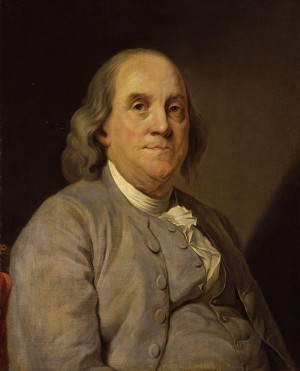
Not a total hypocrite, Franklin did include passages in his writing that treat the pleasures of the table more positively. Poor Richard’s advice that “Fools makes Feasts and Wise Men eat them” suggests that frugality, more than distaste, motivated Franklin’s advice be temperate. During his embassy in Paris, when Franklin sought to win France over to the American cause, he ate out six nights a week. And without a doubt he enjoyed many of the nice things he was served, such as îles flottantes and champagne.
A proud American, Franklin also sought to introduce his French friends to some of the glories of his native cuisine. He insisted that American corn flour could make a sweeter bread than wheat alone (several of the philosophes were engaged in pursuit of a more nutritious bread recipe to improve the condition of the peasantry, who derived the majority of their calories from the staff of life). Later, after his return to Philadelphia, Franklin sent his friends shipments of Pennsylvania hams – remarkable for the sweetness of their fat, which he attributed to the pigs’ subsisting on corn.
If you want to try Benjamin Franklin’s recipe for corn bread you can find it in the appendix to Gilbert Chinard’s wonderful 1958 essay “Benjamin Franklin on the Art of Eating.” This little pamphlet, printed by the American Philosophical Society, contains a number of recipes found among Franklin’s papers, few of which could be described as dietetic. Franklin’s recipe for roasted pig pays great attention to producing a delicious crackling. His oyster sauce is heavy on the cream. And his puff pastry, recommended for encasing his apple pudding, calls for a pound of butter. Franklin’s apple pudding makes a tempting proposition for a food historian on the eve of Thanksgiving, especially since, like many eighteenth-century recipes, Franklin’s terse instructions offer just enough detail to inspire certainty that the end result would be inedible by twentieth-century standards. What better reason could there be to break out the mixing bowl!
* * * * *
To make an apple pudding.
Make a good puff-paste, roll it out half an inch thick, pare your apples, and core them, enough to fill the crust, and close it up, tie it in a cloth and boil it. If a small pudding, two hours: if a large one three or four hours. When it is enough turn it into your dish, cut a piece of the crust out of the top, butter and sugar it to your palate; lay on the crust again, and send it to table hot.
* * * * *
The sense of the unfamiliar has always been what compels me about history, it gives me the feeling of discovery and assures me that I am not just finding my own reflection in the sources. I, for example, do not bring a love of boiling to my reading of dessert recipes. Baking I expect – hours of boiling, not so much. I boil few foods, and those only briefly. I boil pasta 7 to 12 minutes, always anxious to drain the pot while the noodles are still al dente. Sometimes I boil green beans, but just for a couple minutes and often I steam them instead. I boil eggs, but I like the yolks soft so I don’t leave them in for more than six minutes. I never boil dessert pastries. But Benjamin Franklin told me to, so for the sake of historical knowledge I threw all my cooking know-how to the wind and set out to slavishly follow his orders.
Difficulties confronted me long before I arrived at the boiling. To begin, Franklin directed that I make a puff pastry, mixing four pints, or a quarter of a peck, of flour with half a pound of butter. How much did eighteenth-century dry pints weigh? And did they weigh the same in the colonies as they did in England? Today the imperial wet pint is four ounces more than the American wet pint (20 oz vs. 16 oz). One thing is for certain, whatever the exact weight of an eighteenth-century dry pint might be, four of them is a whopping amount. I made the executive decision to weight a pint at 16 oz and cut the recipe in half so that I didn’t completely empty our flour bin. Halving the butter as well, I ended up with a very dry mix:
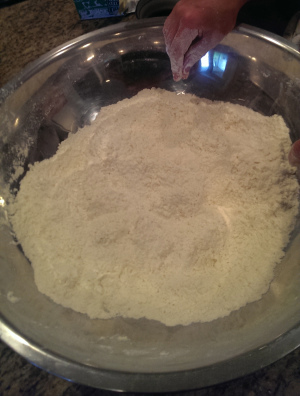
The next direction was to add cold water until a stiff dough formed. Having spent the past twenty-five years of baking trying to add as little water to my pie dough as possible to prevent it turning tough, I needed to tamp down all my better instincts to pour in the cup and a half of cold water that my dry mix required to come together.
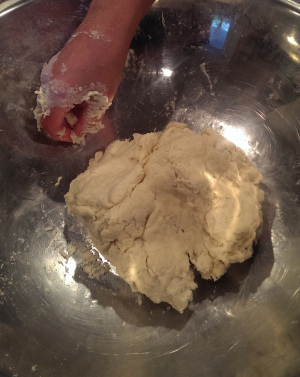
The brick of paste that resulted was so hard that it had to be beat into submission to follow the next directions, which called for the dough to be rolled out, buttered, rolled up, rolled out, and buttered again, nine to ten successive times until another half pound of butter had been added.

After an hour of buttering and rolling, I was left with a lovely, pliable, yellow dough, which I rolled out “half a thumb’s thickness” and set on a cheese cloth.

Franklin’s recipe calls next for chopped cored apples to be placed on the dough. No seasoning is done at this stage: no spices added to the apples, no sugar, no butter, no lemon. Just apples. How big? How many? Over how much of the dough? It doesn’t say.

Nor did the recipe explain how to seal the dough. I went for crimping and ended up with something that looked like a giant Cornish pasty.

At least until I wrapped it up in pastry and began the boiling, whence it commenced to look more like a brain. It was hard to commit willful destruction of this beautiful pasty, rather than pop the parcel into a hot oven where it might grow golden and crisp. What was the purpose of building up 10 layers of lamination only to melt out all the butter in a bubbling pot? Again, Franklin was mute.


The cooking instructions said to boil the pudding from two to four hours depending on its size. Unsure of the standard of measurement, I decided on three hours. There were no further cooking directions and perhaps I should have just let it be, but worried that the pudding wasn’t getting cooked on the top, which bounced above the bubbling water, I flipped the package each hour. Perhaps if I hadn’t, the pudding would have developed more of a crust.
For the final step, Franklin directs that the top of the pudding be removed, sugar and butter be mixed in with the apples, then the top replaced and the whole served immediately. When I cut away the muslin and lifted the soggy lid I found that the apples inside had reduced to a beautiful sauce within the boiled pastry casing. I added some chopped butter and brown sugar, then closed the pudding back up and let the flavors meld. I can’t say the result would win first prize in a pie contest, it wouldn’t even win honorable mention. But I can report that the mess tasted quite nice in a bland, comforting, soft, sort of way. Not a bad match for turkey at all.
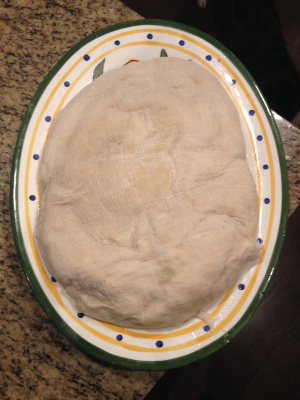


Featured image: “The First Thanksgiving,” Jean Leone Gerome Ferris (c. 1912). Public domain via Wikimedia Commons.
The post Thanksgiving with Benjamin Franklin appeared first on OUPblog.









 Related StoriesTop 10 Turkey-Dumping Day breakup songsGive thanks for Chelmsford, the birthplace of the USAThe legitimate fear that months of civil unrest in Ferguson, Missouri will end in rioting
Related StoriesTop 10 Turkey-Dumping Day breakup songsGive thanks for Chelmsford, the birthplace of the USAThe legitimate fear that months of civil unrest in Ferguson, Missouri will end in rioting
Place of the Year 2014 nominee spotlight: Ukraine
With only one more week left until we announce Place of the Year 2014, we’d like to spotlight another one of the places on our shortlist: Ukraine. The country entered the news early in 2014 when a referendum held in Crimea resulted in the peninsula uniting with Russia. As the twenty-first edition of the Atlas of the World notes, Crimea currently remains under Russian control, though this union is not internationally recognized.
For a little more information about Ukraine, take a look below at the eight facts we compiled about the country’s history, places, and people.
1. According to OxfordDictionaries.com, the origin of the name “Ukraine” is “from Old Russian ukraina ‘border region,’ from u ‘at, beside’ + kraĭ ‘edge, border.’”
2. Ukraine’s capital, Kiev, has been an important settlement since the Middle Ages, when it was the capital of early Slavic civilization, Kievan Rus.
 Kyiv, the capital of Ukraine, at night. By Anton Molodtsov/Tony Wan Kenobi. CC-BY-SA-2.0 via Wikimedia Commons.
Kyiv, the capital of Ukraine, at night. By Anton Molodtsov/Tony Wan Kenobi. CC-BY-SA-2.0 via Wikimedia Commons.3. Out of all the countries in Europe, Ukraine is second only to Russia in geographic size, with an area of 233,089 square miles, or 603,700 square kilometers.
4. The most common religion in Ukraine is Ukrainian Orthodox.
 Orthodox cathedral in Nova Kakhovka. Public domain via Wikimedia Commons.
Orthodox cathedral in Nova Kakhovka. Public domain via Wikimedia Commons.5. An overwhelming 78% of the country’s population is ethnically Ukrainian, with the next largest ethnic group in the country being Russian (17%).
6. Prypiat, Ukraine remains a ghost town to this day as a result of the Chernobyl disaster in 1986 that left the city uninhabitable.
 Swimming Pool Hall 4 Pripyat by Timm Suess. CC-BY-SA-2.0 via Wikimedia Commons.
Swimming Pool Hall 4 Pripyat by Timm Suess. CC-BY-SA-2.0 via Wikimedia Commons.7. Although he is often grouped with Russian authors like Alexander Pushkin, Leo Tolstoy, and Anton Chekhov, Nikolai Gogol was born in Velyki Sorochyntsi, modern-day Ukraine, and is ethnically Ukrainian and Polish.
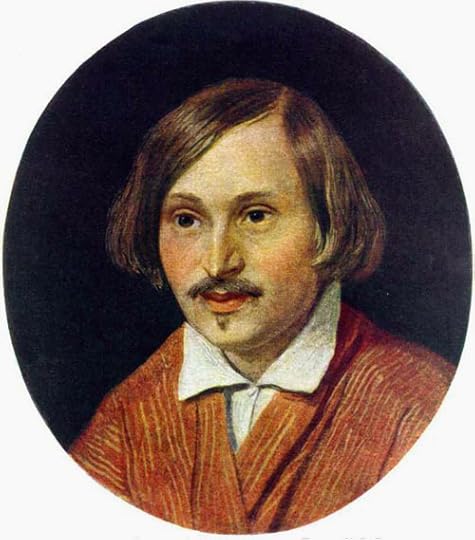 Nikolai Gogol by Alexander Andreyevich Ivanov, 1847. Public domain via Wikimedia Commons.
Nikolai Gogol by Alexander Andreyevich Ivanov, 1847. Public domain via Wikimedia Commons.8. Ukraine has been independent since the break-up of the Soviet Union in 1991. Currently, Ukraine’s government is a multiparty republic, and Petro Poroshenko is president.
Do you think Ukraine should be Place of the Year? Cast your vote!
The Place of the Year 2014 shortlist
Don’t forget to vote and follow along with #POTY2014 until our announcement on 1 December to see which location will join previous Place of the Year winners.
Image credit: Flag of Ukraine by UP9. CC-BY-SA-3.0 via Wikimedia Commons.
The post Place of the Year 2014 nominee spotlight: Ukraine appeared first on OUPblog.









 Related StoriesPlace of the Year 2014 nominee spotlight: Scotland [quiz]Announcing the Place of the Year 2014 shortlist: Vote for your pickPlace of the Year 2014 nominee spotlight: Brazil [Infographic]
Related StoriesPlace of the Year 2014 nominee spotlight: Scotland [quiz]Announcing the Place of the Year 2014 shortlist: Vote for your pickPlace of the Year 2014 nominee spotlight: Brazil [Infographic]
Top 10 Turkey-Dumping Day breakup songs
The last Thursday of November freshmen are returning home to reunite with their high school sweethearts. Except not all are as sweet as they once were. Your old flame may show up with a new admirer or give you trouble because you didn’t spend enough time on Skype on Saturday nights while away at college. Be prepared: pack an arsenal of tunes that catch the sad and sometimes mixed feelings you may have after Turkey-Dumping Day. For your convenience, a list of the 10 great breakup songs for a post-Turkey recovery:
10. Pink’s “Blow me (One Last Kiss)”
One of the more lighthearted tracks to make the list, Pink’s lead single from her sixth studio album The Truth About Love (2012) nonetheless gets the message across: After too much fighting, tears, and sweaty palms, the time comes when turkey is not the only thing you have finally had enough of.
9. Passenger’s “Let Her Go”
Passenger’s second single from the album All the Little Lights (2012) made the list not only because of the soul-wrenching, melodic tune but also because of its spot-on content. Looking into the heart of a dumper, the lyrics forcefully delineate the paradox of love: you don’t really know whether or how much you love someone, until he or she is gone.
8. Christina Perri’s “Human”
The lead single from Perri’s second studio album Head or Heart (2014), this pop power ballad features almost no drumsticks (pun intended). Instead it showcases the American singer’s ethereal voice. And the lyrics hit the nail on the head: Being happier and hotter without your ex may be the best way to get even. But don’t worry if you fail spectacularly, ’cause you’re only a little human.
7. Hilary Duff’s “Stranger”
Tapping into the style and sound of Middle-eastern belly-dance music, Hilary Duff’s single, recorded for her fourth studio album Dignity (2007), is a bouncy yet husky song about suddenly seeing an unkind stranger in the torso of your beloved. After listening to this tune, put on the dumper’s apron before slicing the turkey.
6. Jaymes Young’s “Parachute”
Despite its blunt language, Seattle-born singer Jaymes Young’s fragile ballad made the list because of its lyrics about being lied to and instantly knowing that it’s time to take the “l” out of “lover.”
5. Taylor Swift’s “I knew you were trouble”
Taylor Swift’s bass-heavy dubstep drop, recorded for her fourth studio album Red (2012), is aptly warning us about the trouble-makers–those types that make you fall in love only to leave you behind.
4. Sam Smith’s “Stay with me”
Although it’s not quite a turkey-dumping song but rather a desperate-for-love ballad, this gospel-inspired hit from British songwriter Sam Smith’s debut studio album In the Lonely Hour (2014) still made the list. Critics deemed it overly sentimental, but “brutally honest” is evidently a better description.
3. David Guetta’s “Titanium”
French DJ and music producer David Guetta is hard to pass over when it comes to ferocious breakup songs. This 2012 hit from his album Nothing But the Beat gives you relationship hardship and a shot of resilience to help take the pain out of Turkey-Dumping Day.
2. Fefe Dobson’s “Stuttering”
“Dobson can sing,” say the critic. Yes, indeed. The tune and the debated music video leave you stuttering and wondering: Can the green-eyed monster make you that crazy? Yes, it can, not least when the cheater isn’t your man.
1. David Guetta’s “She Wolf”
Katy Perry’s “Part of Me” gets an honorary mention for its heartening lyrics but it’s David Guetta who takes the first place with another ballad, featuring vocals from Australian recording artist Sia. Reflecting on the most poignant of breakups, this impassioned chorus on the feeling of being replaced takes us inside the mind of someone who is “falling to pieces.”
Headline image credit: Broken Heart Grunge by Nicolas Raymond. CC BY 2.0 via Flickr
The post Top 10 Turkey-Dumping Day breakup songs appeared first on OUPblog.









 Related StoriesWho is your favourite fairy-tale character?Leaving Orthodox Judaism: A Q&A with Lynn DavidmanVampires and life decisions
Related StoriesWho is your favourite fairy-tale character?Leaving Orthodox Judaism: A Q&A with Lynn DavidmanVampires and life decisions
Joseph Smith and polygamous marriage
A number of historians of Mormon history have tried to explain the rationale and motivation behind Joseph Smith’s teachings about “plural marriage.” Although it’s not unreasonable to assume a sexual motivation, Smith’s primary motivation may have been his expansive theology–a theology, in this specific case, that his wife would not accept.
After establishing his new church in 1830 and while continuing to study the Bible, Smith’s far-reaching religious vision to restore “all things” from previous ages made him open to reinstating Old Testament polygamy, explains historian Richard Van Wagoner. Perhaps the timing was right: Americans had won the Revolutionary War and were open to “the surprising and unusual in religious life, according to historian Merina Smith, and in the early 1840s, a core group of Joseph Smith’s believers accepted his developing “exaltation narrative” that included “new family forms.” Joseph Smith biographer Richard Bushman explains that Joseph Smith began to imagine “ecclesiastical and family kingdoms that would persist into eternity.” University of Richmond professor Terryl Givens explains that Smith sought to establish a “timeless and borderless web of human relationships” among his followers, just as the great appeal of first-generation Christianity in the ancient world was “the feeling of entering into an extended family community.” For Joseph Smith, marriage “sealings” joined people, and he was even sealed to some married men and women.
 Image credit: “St. George Utah Temple, From South” by Michael Whiffen. CC-BY-2.0 via Flickr.
Image credit: “St. George Utah Temple, From South” by Michael Whiffen. CC-BY-2.0 via Flickr.Although there’s evidence that Joseph Smith seemed most interested in creating an interconnected web of believers that could be exalted together, Bushman says Smith “never wrote his personal feelings about plural marriage” and, according to historian John G. Turner, “whether [he] was motivated by religious obedience or pursued sexual dalliances clothed with divine sanction cannot be fully resolved through historical analysis.” We don’t know to what extent Joseph Smith pursued sexual relations with his wives, and according to Bushman, although “nothing indicates that sexual relations were left out of plural marriage, not until many years later did anyone claim Joseph Smith’s paternity, and evidence for the tiny handful of supposed children is tenuous.” But his wife Emma’s negative reaction to his additional marriages may indicate that she, at least, felt his ideas, if not his actions, went too far.
In the early 1840s as Smith secretly began marrying additional wives and encouraging his closest confidantes to do the same, of course he feared “wrecking his marriage,” as Bushman explains it. During this time, according to Emma Smith’s biographers Linda King Newell and Valeen Tippetts Avery, Smith repeatedly tried to explain “plural marriage” to his wife Emma, sometimes taking her alone on long buggy rides to talk to her about it. In May 1843 after much convincing, Emma finally gave her consent to a polygamous marriage and participated in her husband’s marriage to two sisters, giving her “free and full consent.”
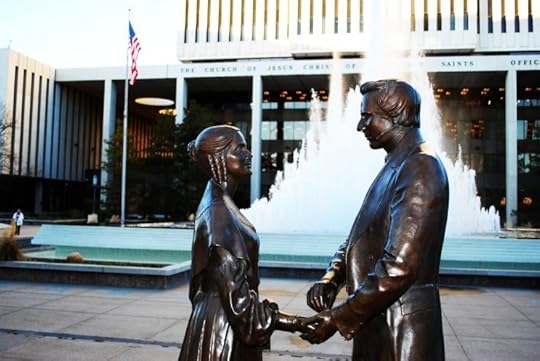 Image credit: “Joseph and Emma” by Edgar Zuniga Jr. CC BY-ND-2.0 via Flickr.
Image credit: “Joseph and Emma” by Edgar Zuniga Jr. CC BY-ND-2.0 via Flickr.Not long afterwards, however, according to Bushman, “Emma began to talk as firmly and urgently to Joseph about abandoning plural marriage as he had formerly talked to her about accepting it.” In the spring of 1843, “the recovery of his domestic life” became “almost impossible.” As Bushman explains, “They were in impossible positions: Joseph caught between his revelation and his wife, Emma between a practice she detested and belief in her husband.” Evidently fearing the legal and financial ramifications of many wives, Emma requested half ownership of a steam boat and “sixty city lots,” and Joseph evidently agreed “to add no more” wives. If he did, he told friend and secretary William Clayton, Emma “would divorce him.” Under these conditions, Joseph and Emma reconciled. Tragically, in 1844, he was murdered by an angry mob, and Emma deeply mourned his death.
Starting in 1852 in Utah, polygamous marriage was openly encouraged by Smith’s successor Brigham Young, and about 25 to 30% of Mormon men, women, and children lived in polygamous families. In 1876, Smith’s revelation on “celestial marriage”–marriage which endures after death and which could include “plural marriage”–was canonized in a Mormon book of revelations called Doctrine and Covenants. In 1890, Mormons officially gave up polygamy but not the larger belief in celestial marriage. Today Mormon marriages still encompass the essence of Smith’s original theology–celestial, or eternal, marriage–as monogamous couples continue the practice of sacred marriage “sealings” to each other and to their ancestors, fulfilling Smith’s desire to vertically, horizontally, and everlastingly connect Latter-day Saints.
Featured image: Image taken from page 277 of ‘Life in Utah‘ by British Library (1870). Public domain via Flickr.
The post Joseph Smith and polygamous marriage appeared first on OUPblog.









 Related StoriesSix questions with Amy DeRogatisLeaving Orthodox Judaism: A Q&A with Lynn DavidmanRepresentations of purgatory and limbo in popular culture
Related StoriesSix questions with Amy DeRogatisLeaving Orthodox Judaism: A Q&A with Lynn DavidmanRepresentations of purgatory and limbo in popular culture
Who is your favourite fairy-tale character?
From wicked step-mothers to fairy god-mothers, from stock phrases such as “once upon a time” to “happily ever after”, fairy-tales permeate our culture. Disney blockbusters have recently added another chapter to the history of the fairy-tale, sitting alongside the 19th century, saccharine tales published by the Brothers Grimm and the 17th century stories written by Charles Perrault. Inspired by Marina Warner’s Once Upon a Time, we asked OUP staff members to channel their inner witches, trolls, and princesses, and reveal who their favourite fairy-tale character is and why. Do you agree with the choices below? Who would you choose?
* * * * *
“The outlook is not promising for my favourite fairy-tale character, Kai, towards the end of Hans Christian Andersen’s The Snow Queen. With splinters from the troll’s mirror in his eye and his heart (that have turned him evil), Kai is a prisoner of the Snow Queen being forced to spell out the word ‘eternity’ using pieces of ice, in the manner of a Chinese puzzle. And he does it all for the childish promise of a pair of skates. Knowing the author’s penchant for unhappy, complicated endings, I was greatly relieved when the story ends with Kai’s childhood love Gerda coming to the rescue!”
— Taylor Coe, Marketing Coordinator
* * * * *
“Though I have many favorite characters, the one that has been consistent throughout my life is Ariel/The Little Mermaid. I have always been fascinated by the ocean so her story stood out amongst the other fairy-tales when I was growing up. I admire her ability to recognize what she wants, and her courage to change her circumstances, no matter the consequences. She is curious and always seeks out new experiences, which I relate to. Ariel’s story reminds us to question our surroundings and create adventurous lives.”
— Molly Hansen, Marketing Associate
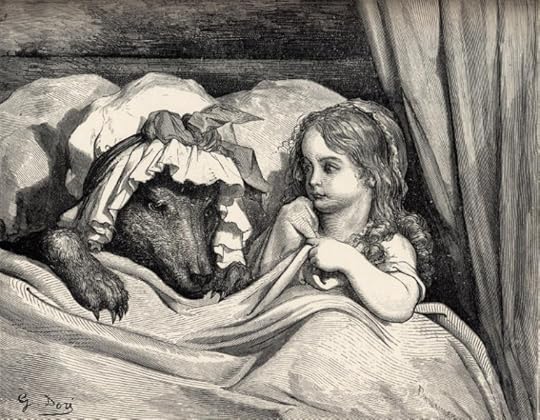 Le petit chaperon rouge, by Gustave Doré. Public domain via Wikimedia Commons.
Le petit chaperon rouge, by Gustave Doré. Public domain via Wikimedia Commons.* * * * *
“Baba Yaga. She has long been my favorite mainly because of the sound, rhythm, and cadence with which my mother (who first told me the story from a children’s book of fairy-tales) said ‘Baba Yaga, the boney-legged’. All sorts of possibilities lay within those five words. (I later learned my mother was mispronouncing ‘Baba Yaga’.) I think what her story distinct is that Baga Yaga was an individual. Normally fairy-tale characters, especially villains, are nameless : a witch, a wicked stepmother, etc. (this was before I learned it simply means ‘old woman’). Baba Yaga had a home (with chicken legs!); she didn’t live in some random cottage that inept children could find. Baga Yaga belonged in the (fairy tale) universe just as much as the heroes. (I have no idea what the hero’s name was supposed to be.)”
— Alice Northover, Social Media Marketing Manager
* * * * *
“Mine is La belle au bois dormant – or Sleeping Beauty. Just the thought of sleeping in peace for 100 years sounds like heaven to me. I’m not so fussed about being awoken by a kiss from a prince – I’d rather he came with a large cup of tea!”
— Andrea Keegan, Senior Commissioning Editor
* * * * *
“My favourite fairy-tale character is one I can’t actually pronounce: Snegurochka. For those who don’t speak Russian – and I modestly include myself among that number – Snegurochka (or Snegurka) is known in English as The Snow Maiden. It’s about a girl made of snow, by a poor, childless couple, who unexpectedly comes to life. Most versions of the story end relatively tragically, but I love the mixture of fantasy and real life. It’s very poignant, and lends itself to many different retellings.”
— Simon Thomas, Marketing Executive
* * * * *
“I have always been a fan of the Brothers Grimm fairy-tale Snow White and Rose Red. Since one sister shares a name with the other fairy tale princess, I think these young ladies often are overlooked. I love that they are brave enough to be generous and kind even to those who are different or intimidating. And someone who is ungrateful for their help gets eaten by a bear—a good lesson for us all.”
— Patricia Hudson, Associate Director of Institutional Marketing
* * * * *
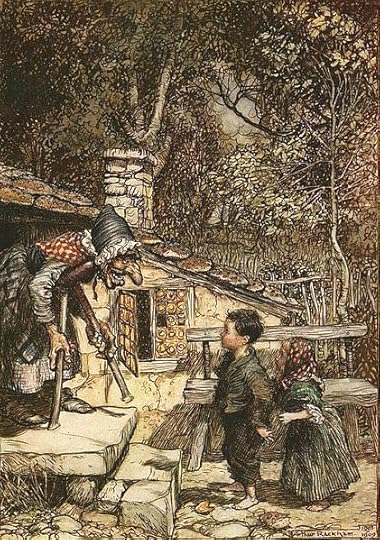 Hansel and Gretel, by Arthur Rackham. Public domain via Wikimedia Commons.
Hansel and Gretel, by Arthur Rackham. Public domain via Wikimedia Commons.
“My favourite fairy-tale character is Puss in Boots because he is such a cunning feline. Ever the loyal cat, he uses his tricks and deceptions to aid his master in pursuit of love and fortune. He is part of a long tradition of the ingenious sidekick, whose skills far outweigh those of their counterpart – in this case his master – who inevitably reap the benefits of the sidekick’s wily ways. It’s got everything really: brains, adventure, romance… and rather adorably, a cat who thinks he’s people.”
— Jennifer Rogers, Team Leader (GAB Operations)
* * * * *
“Peter Pan because he is selfish and charming, earthly and ethereal, vulnerable and bold; he boasts “Oh, the cleverness of me!” and also fearlessly announces “To die would be an awfully big adventure”. He inhabits a dream-world and delights in enticing us to join him; to leave off adulthood and rekindle our childhood spirit & imagination.”
— Suzie Eves, Marketing Assistant
* * * * *
“I’ve always loved the tales of Fionn mac Cumhaill, the Irish warrior. He’s a shape-shifter in mythology; sometimes a man, sometimes a descendant of magic people, sometimes a giant. As a giant, he built the Giant’s Causeway to give him a stepping stone to Scotland. During a feud with a Scottish giant he dug out a clump of earth to throw at his rival; the hole where the earth had been became Lough Neagh, the earth (which fell short of Scotland) became the Isle of Man. It is said that he never died, but lies asleep underground, and will wake to protect Ireland and the Irish people when they need him most. I love these tales, as they speak to me of the places of my childhood, and when I visit the Giant’s Causeway, I almost feel like I could round a corner to find Fionn stepping in his giant boots across the Irish Sea.”
— Cathryn Steele, Assistant Commissioning Editor
* * * * *
“My favourite fairy-tale character is the old shoemaker, who worked very hard and was very honest, but who couldn’t earn enough to feed his family. He unknowingly receives the help of the nocturnal elves, who themselves have nothing, not even clothes on their backs, but who work all night to turn leather into beautifully crafted shoes. The eventually success of the old shoemaker did not change him and he repaid the elves kindness with Christmas presents of fancy shirts, bright pantaloons, and teeny tiny clogs, and the elves went away happy and dancing. A lovely lesson not to forget those who helped us get where we are. It also reminds me of what parents say when they’ve performed a thankless task, “the elves must have done it!”. Perhaps it’s really a hint that they deserve a nice present at Christmas!”
— Alison Jones, Managing Editor (Open Access)
* * * * *
“My favourite fairy-tale character is the horse Dapplegrim. I always loved how he was the brains and also the brawn in his fairy tale, and how the story was really about him, instead of about the prince and the princess who usually feature so centrally in fairy-tales. With his help his master was able to complete the tasks he was set and marry the princess, but Dapplegrim never asked for his own reward. His story had everything – magic, shape-shifting, seemingly-impossible tasks, a beautiful princess/sorceress to win, and a battle. Dapplegrim always came out on top.”
— Jenny Nugee, Administative Assistant
* * * * *
“As a child I remember being horrified and fascinated by the Grimm’s Fairy Tales. The more horrible the story, the more I loved it. Yet, it was not until I was a full-grown adult that I discovered my favorite book of fairy-tales. It was in the mid-90s when I was in my late 20s, living in Hoboken, NJ. My bedroom window looked out the back onto the backroom of a local pub, The Shannon Lounge. It was in the backroom of the Shannon Lounge that I witnessed a strange puppet show inspired by Heinrich Hoffmann’s Der Struwwelpeter. Here are wondrous tales of kids catching fire for playing with matches, and tall lanky men snipping off the thumbs of thumb sucking minors, or what would happen if you tipped in your chair at the dinner table, and many other cautionary tales for obstreperous brats that paid little heed to the wisdom of their parents and elders.”
— Christian Purdy, Publicity Director, GAB Marketing
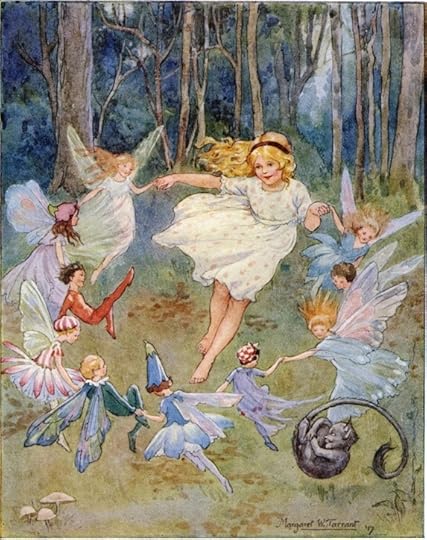 Fairy-tale illustration, by Margaret Tarrant. CC-BY-NC-2.0 via Flickr.
Fairy-tale illustration, by Margaret Tarrant. CC-BY-NC-2.0 via Flickr.* * * * *
“I’ve always had a soft spot in my heart for the lesser-known but very sweet Brave Little Tailor. He becomes king because of a series of calculated heroic actions, including clever wordplay (he kills “seven at one stroke,” he claims, referring not to men but to the seven flies he killed at breakfast) and defeating giants without even touching them (he turns them on each other, instead). He moves up the social ladder and marries the princess all due to his wit and cleverness—and maybe some white lies here and there…”
— Georgia Brodsky, Marketing Coordinator
* * * * *
“The best characters are almost always the evil ones! I love the Queen in Snow White, particularly in the Brothers Grimm telling of the story. Her impressively creative attempts to kill Snow White are fascinating, and I’m pretty sure that I can relate to her demise: dancing in red-hot shoes until she drops dead.”
— Caroline James, Editor
* * * * *
“I’ve always had a soft spot for the Ugly Duckling. As a very sensitive kid, I agonized with the baby bird at every step of his journey and was elated when he found his true family. Then, as a typically insecure teenager, I dreamed of having a transfiguration of my own. Now, as I tell the story to my daughter, it reminds me how important it is to treat even the scruffiest of ducklings more like potential swans.”
— Beth Craggs, Communications Executive
* * * * *
“One of my favourite fairy-tale characters is the dog with the eyes as big as saucers in The Tinderbox. I like him because even though the treasure he guarded was the least valuable, he is no less intimidating as a character. As a child I wished I had a dog, so the idea of having three big dogs you could summon at any time also had great appeal!”
— Iona Argyle, Programme Administrator
* * * * *
“My favourite fairy-tale character has to be Roald Dahl’s feisty Little Red Riding Hood. Dahl’s ability to challenge traditional roles and inject any story with a wicked spark of fun made his books a mainstay of my childhood. As a feminist, and someone who has watched the obsession with ‘perfect princesses’ with increasing dismay, the killer lines in this poem feel like a perfect antidote:”
‘The small girl smiles. One eyelid flickers.
She whips a pistol from her knickers.
She aims it at the creature’s head
And bang bang bang, she shoots him dead’
— Emma Duke, Group Communications Manager
* * * * *
The post Who is your favourite fairy-tale character? appeared first on OUPblog.









 Related StoriesThe literature and history of ChaucerOnce upon a time, part 2Once upon a time, part 1
Related StoriesThe literature and history of ChaucerOnce upon a time, part 2Once upon a time, part 1
Oxford University Press's Blog
- Oxford University Press's profile
- 238 followers



